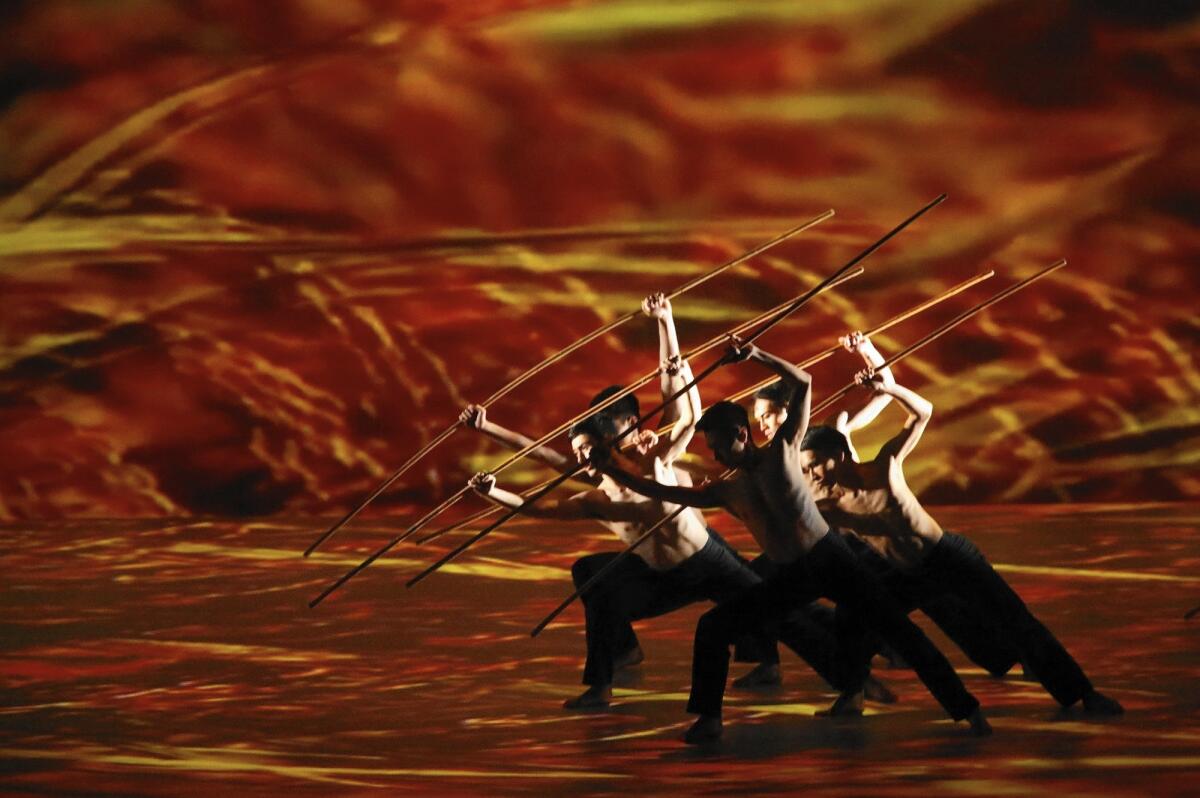Review: Cloud Gate’s ‘Rice’ is a timeless puzzle

- Share via
Like many rice makers, my Japanese model has a button labeled “Quick.” How quick I couldn’t say: I’ve never tried it. My instinct is that rice shouldn’t be rushed. I always use the slowest setting, which requires nearly four hours for the rice to cook.
The machine’s instructions recommend a 10-minute ritual of soaking and rinsing the rice. Then the rice maker’s fuzzy logic does its intriguing work. The result is invariably mysterious and delicious.
See more of Entertainment’s top stories on Facebook >>
“Rice,” the latest work by Cloud Gate Dance Theatre of Taiwan, is only 70 minutes. But the performance at the Dorothy Chandler Pavilion on Sunday afternoon had many similar qualities to this kind of rice preparation. It feels timeless. It is ritual-based. And while themes such as the cultivation of rice and its relationship to the environment and to the culture of Asia aren’t uncommon, “Rice” remained mysteriously mouthwatering.
All of this is to say that I have some notion about how this dance — created by Cloud Gate’s founder and artistic director Lin Hwai-min — operates as I do about the fuzzy logic of the rice maker and about Buddhism, which is another aspect of this dance. But much of “Rice” and most likely its essence resist elucidation.
Certain things, though, are obvious. The 24 members of the 40-year-old company are marvelous, multifaceted dancers. They are masters of abstract modern dance, with stillness and poise a specialty. They have further acquired acrobatic and martial arts skills. They have a presence that rivets attention. They all seem to come from the same dance mold, yet they remain individuals who invite you to study their faces.
“Rice” begins with a dancer carrying a springy bamboo pole. He walks calmly across the stage. The curtain behind him is raised part way, and on a screen is projected video of rice fields, plants gracefully blowing in the wind, just as the bamboo gracefully bends on Yang I-chun’s shoulder.
He is followed by eight women wearing pale, pastel long skirts. They pound the floor yet seem even more graceful than he. The music is traditional Hakka folk songs. Eventually they become a ferocious, eight-headed creature that could be out of Greek mythology. All have exactly the same striking, frightening, thrilling look in their steely eyes as they become this fearsome thing of wonder. The section is called “Soil.” That sort of makes sense.
“Wind,” “Pollen I” and “Pollen II,” “Sunlight,” “Grain,” “Fire” and “Water” are the sections that follow. It is not always easy to tell the point when one part ends and another begins or exactly what the dance is telling us. The men use their poles for martial arts exercise. The women, whom Lin tends to use more interestingly than the men, elegantly transform the poles into rapier-like stalks of grain.
In “Pollen II,” two sinewy bodies erotically cross-pollinate as they intertwine in dim light with more swaying rice fields projected behind them. The music here is an arrestingly beautiful vocalise by the Japanese composer Maki Ishii. That sort of makes sense too.
But the music for “Sunlight,” the most martial section, is incongruously “Casta Diva” from Bellini’s opera “Norma” (the recording sounded like Maria Callas). On this stage, the impression is of something having been left behind from L.A. Opera’s production of the opera in the Dorothy Chandler Pavilion earlier in the season.
“Grain” begins with dancer Chou Chang-ning assuming painful contortions. Has she been painfully turned into stalks of grain as some kind of punishment?
We move on. The dance becomes more and more abstract. “Fire” and “Water” evoke ethereal slowness and timelessness. Seventy minutes could be all day or a fleeting second.
The music gets curiouser and curiouser. Mahler’s setting in his Third Symphony of the “Midnight Song,” from Nietzsche’s “Also Sprach Zarathustra,” comes out of nowhere. The world is deep, a mezzo sings, deeper than day has thought. Pain is deep, deeper than heartache. Joy seeks that that is deepest of all — eternity.
Yang I-chun and the women who opened the performance end it. The seasons have turned. Rice and the land have undergone rebirth, maybe. Maybe not. We’re where we were when we began, but nothing is familiar, not even the Mahler. The rice, I think, is ready.
More to Read
The biggest entertainment stories
Get our big stories about Hollywood, film, television, music, arts, culture and more right in your inbox as soon as they publish.
You may occasionally receive promotional content from the Los Angeles Times.











